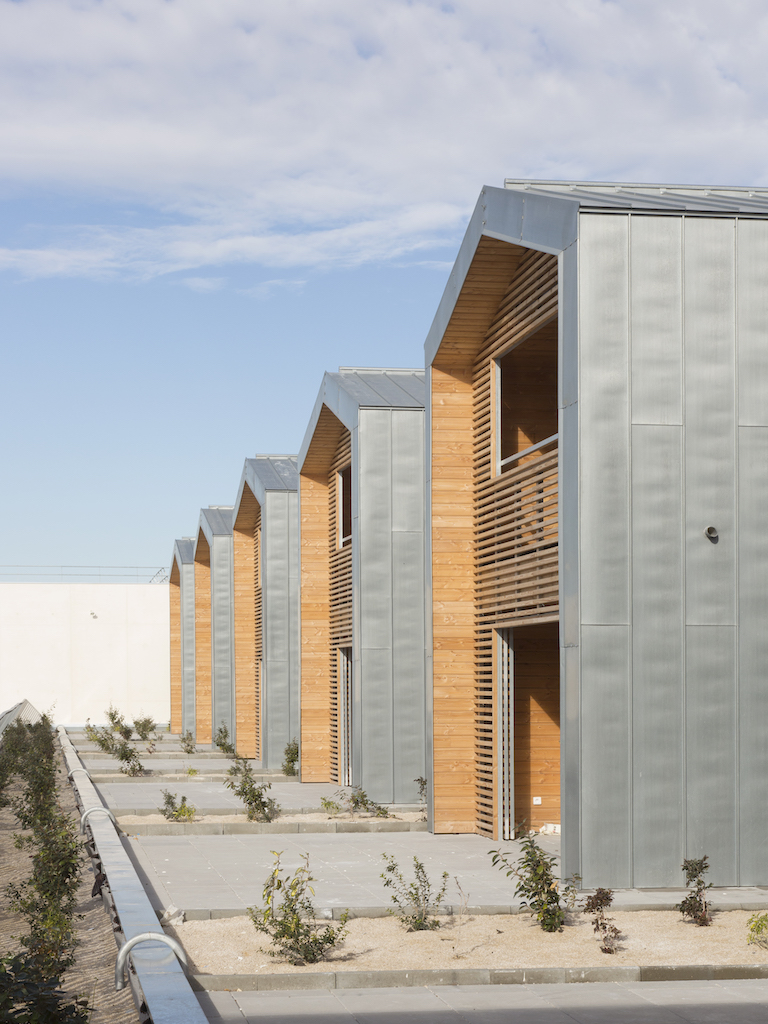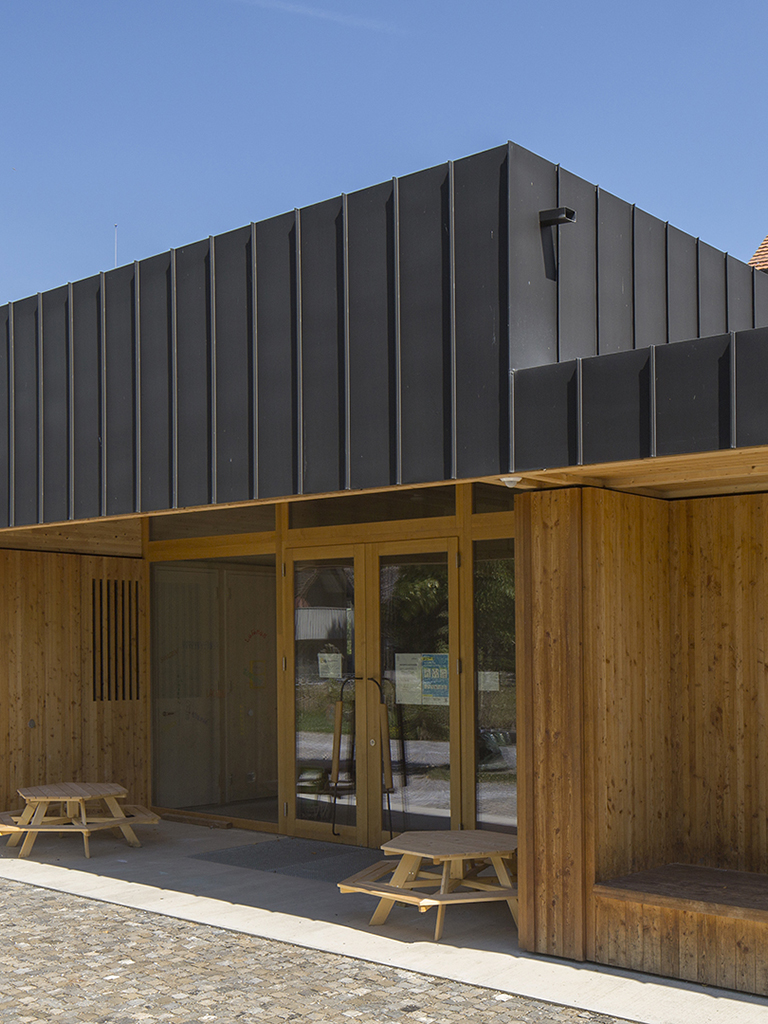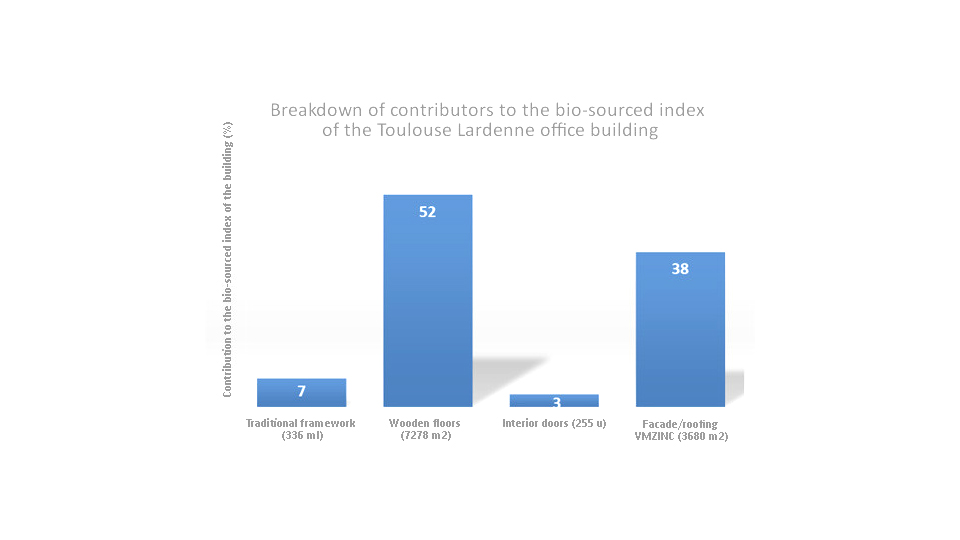Zinc and wood synergy
The majority of VMZINC solutions use wood for support in the rolled zinc constructive system. There is a perfect synergy of those two materials.

Blending materials is a particularly effective architectural strategy in itself as it can provide solutions to a range of various concerns. This is particularly the case for zinc and wood which fit together perfectly.
The majority of VMZINC solutions use wood for support in the rolled zinc constructive system.
Zinc and wood allow solutions which are: elegant (e.g. warmth of wood, modernity of rolled zinc), technical (e.g. rigidity of wood, durability of zinc), functional (e.g. support of wood, protection of rolled zinc), economic (e.g. development of local industry and small companies), and environmental (e.g. low grey energy of wood, recycling of rolled zinc).
VMZINC systems and wood payloads
Whether it is used for decking, secondary frameworks or roll caps, wood is widely used in VMZINC facade and ventilated roofing systems (Table 1).
Wood in VMZINC roofing and facade systems
Application | VMZINC Systems | Decking | Framework |
|---|---|---|---|
Roofing | VMZINC Roll cap | x | x |
| VMZINC Standing seam | x | x | |
| VMZINC Structural roof (20% of cases) | x | ||
Facade | VMZINC Standing seam | x | x |
| VMZINC Flat lock panel | x | x | |
| VMZINC Interlocking panel | x | ||
| VMZINC Overlapping panel | x | ||
| VMZINC Sine wave profile | x | ||
| MOZAIK |
Wood payload/m2 of VMZINC system
| Application | VMZINC Systems | Wood (kg/m2)* |
|---|---|---|
Roofing - Continuous decking | VMZINC Roll cap - I - 500 mm | 13 |
| VMZINC Roll cap - I - 650 mm | 12.5 | |
| VMZINC Standing seam | 10.5 | |
| VMZINC Structural roof (20% of cases) | ||
Facade - continuous decking | VMZINC Standing seam | 10.1 |
| VMZINC Flat lock panel | 10.1 | |
| ADEKA | 10.1 | |
| VMZINC Interlocking panel | 2 | |
| VMZINC Overlapping panel | 2 | |
| VMZINC Sine wave profile | 1.8 |
*Considering an average thickness of decking (18mm on facade, 15 mm on roofing), an average section of secondary framework (5x5 cm2 on facade, 6.5x7.3 cm2 on roofing) or roll cap (h=40mm), density of 450 kg/m3 for the wood used (fir wood), a gap of 60 cm between frameworks and a scrap rate of 5%.
VMZINC and the "Bio sourced building label"
Thanks to the technical and functional synergy of rolled zinc and wood, VMZINC systems can integrate 13 kg of wood per m2 installed (even more for decking whose thickness exceeds 15 mm). The choice of VMZINC systems for roofing or facades is therefore a significant lever for action in obtaining the “Bio-sourced Building” label
The “Bio-sourced building” label
In compliance with Decree n° 2012-518 of 19 April 2012 and the Ministerial Decision of 19 December 2012, the “Bio-sourced building” label states the compliance of a new building with a benchmark incorporating:
- Respect of a minimum rate of incorporation of bio-sourced building products and fixed assets into the building (with minimum requirements).
- Blending requirements relating to the function of the bio-sourced building products or the family of bio-sourced products implemented.
- Minimum control methods defined in appendix I.
Only bio-sourced building products with a French Environmental and Health Declaration – FDES enter into the scope of application of this label.
The bio-sourced index is expressed in kg/m2 of Floor Surface.
The bio-sourced label features 3 levels according to the value of the bio-sourced index calculated on the overall scale of the building.
The 3 “Bio-sourced building” label levels
| Main type of use | Rate of incorporation of bio-sourced material with “bio-sourced building” label (kg/m2 of floor surface) | ||
|---|---|---|---|
| Facade system – Continuous decking | 1st level 2013 | 2nd level 2013 | 3rd level 2013 |
| Individual house | 42 | 63 | 84 |
| Industry, storage, transport service | 9 | 12 | 18 |
| Other uses (collective housing building, hotel accommodation, trade, teaching, agricultural building, etc.) | 18 | 24 | 36 |

VMZINC systems: levers of action to obtain the “bio-sourced” building label
VMZINC solutions, especially those installed on decking, promote the use of wood in construction.
The use of VMZINC solutions on the facade or roof of a building is therefore a significant lever of action to improve its bio-sourced index (expressed in kg of wood/m2 of Floor Surface) and to obtain the “Bio-sourced building” label if necessary.
The increase by 2 mm of the thickness of decking makes it possible to increase by approximately 1 kg the wood payload per m2 of VMZINC system installed.
Case study
The Toulouse Lardenne office building (BBC and “HQE® Method – Commercial building” certified), which uses 3,700 m2, standing seam cladding in ANTHRA-ZINC, served as a case study for the Dauchez Payet engineering firm to assess the influence of VMZINC solutions on the bio-sourced index of buildings.
This study demonstrated that the VMZINC solutions used on the facade contribute to 30% of the bio-sourced index of this office building.
VMZINC systems contribute 10 times more than the 255 doors and represent 4/5 of the 7,278 m2 of wooden flooring in the Toulouse Lardenne office building
Diagram: Breakdown of contributors to the bio-sourced index of the Toulouse Lardenne office building

